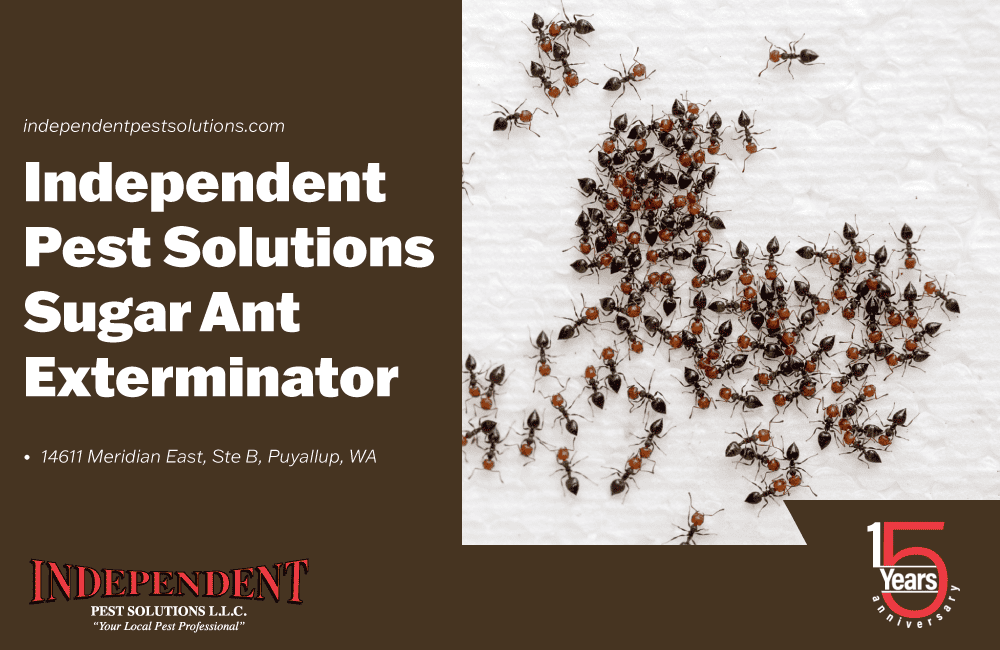Odorous House Ants Pest Control
Odorous house ants (also called sugar ants) are one of the most common types of ants in the Pacific Northwest, and live all over the continent. They are at peak activity in the warmer summer months. The scientific name for this species is Tapinoma sessile. They get their common name, odorous house ants, from the distinctive smell they give off when they are crushed, which is like blue cheese or rotten coconut. Although odorous house ants generally don’t cause harm to humans, they can contaminate food and be a big nuisance.
Odorous house ants are dark brown or black-colored, and range from being about one-sixteenth to one-eighth an inch long in size. Like all other insects, they have six legs. Their antennae have twelve segments in them. This type of ant does not have an obvious node at their waist, because the ant’s rear covers it. Its single node is flattened. On the last segment of their rears, they have a small horizontal slits. Unlike other types of structural ants, odorous house ants do not have a sting or a circular opening. Odorous house ants lack hair on the back of their thoraxes.
The preferred food by odorous house ants is sweet foods. They also enjoy the honeydew produced by aphid and scale insects. Honeydew is a sticky, liquid waste that some insects secrete, and it is full of sugar. They will eat human sugary foods and beverages, as well as pet food. Sometimes, they eat dead or alive insects.

Odorous Ant Pest Extreminator in the Puget Sound
When odorous house ants are foraging in homes, it is primarily for sweet foods. Odorous house ants forage both during the day and in the cover of the night. The ants follow well-established trails left by other ants. They use pheromone trails to help the other ants find food sources. These trails are in both set trails and wandering patterns. You may find ants walking along the edges of deck boards, door frames, carpets, foundations, baseboards, or siding. They also commonly travel along branches and sidewalks. If odorous house ants are disturbed, their behavior becomes erratic and they raise their abdomens into the air.
Odorous house ants are able to tolerate a wide range of environments and habitats. They can use almost any object as shelter, and can nest anywhere with moisture and heat. It’s common for odorous house ants to relocate their nests every few months because of the rain. If their nest is disturbed, they are able to rapidly relocate to a safer nesting area. However, once the disturbance is over, they are likely to reoccupy the old area. During the winter months, the ants may migrate to nests for overwintering.
When odorous house ants build their nests indoors, they usually make them near sources of moisture. These may include places such as in heaters, inside termite-damaged or damp wood, underneath leaky fixtures, near hot water pipes and other plumbing fixures, in attics, inside vents, in insulation, and in wall voids. When odorous house ants live outdoors, they still prefer moist areas for nesting. This includes mulch beds, beneath wood or stones, under loose tree bark, in exposed soil, in firewood stacks, and under man-made objects.
Odorous house ants generally have large colonies that can have up to 10,000 worker ants and multiple queens. New colonies are established after the ants have mating swarms in the late spring and the first half of summer. Winged males and females fly during this time and mate. After mating, the males die off and the mated females look for a place where they can start a new colony. Mating occurs mostly between individuals from the same nest.
Another way that colonies can divide is through what is called budding or fission. During this process, a queen and worker ants will leave an existing nest carrying brood, and find a new place to establish a subcolony. Odorous house ants might naturally do this when their population becomes too large in the main colony. Human disturbances can also cause this. A colony could split if someone without experience tries to do ant pest control. Because odorous house ants can have multiple queens and their colonies have the ability to split and spread, they are more difficult to manage than some other ant species.

Although odorous house ants do not pose a health risk to humans, they can be a big nuisance. They will take advantage of any food source they can find, and will contaminate it. You do not want to have sugar ants infesting your house. If you notice signs of odorous house ants on your property, reach out to an ant pest control professional in Puyallup. You need an expert pest control company to properly get rid of the ants.
For prevention of odorous house ant infestation, you have to get rid of any possible food and water sources for them. This means eliminating standing water, as well as making sure that all food items in the house are in properly sealed containers. You should also completely clean up any crumbs, spilled food, and sticky spots. Even if it’s a small amount of food, the ants can still use it. You should also keep tree branches cut back from roofs and windows, because odorous house ants can use them to gain access to buildings. It’s also important that there aren’t small openings or cracks in the walls or the bottom of the foundation. Because odorous house ants like to build nests in stacks of wood, you shouldn’t stack building materials or firewood next to the home.
Reach out to Independent Pest Solutions for excellent ant control services. Don’t try to fix the problem on your own- it could make it worse. Odorous house ants can be difficult to get rid of, and methods that work for other ant types may not work on them. Instead, have our experienced pest control technicians handle the issue.


